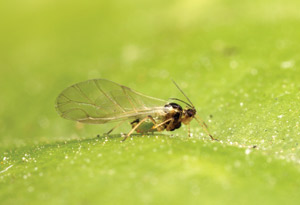News | Regional News
Swarms of insects bugging students across Midwest

Aphis glycines, or soybean aphid, is one of two suspected types of insects believed to be swarming Washington University’s campus. Students have recently reported the bugs clinging to their clothing and skin, amid reports of increased aphid activity in Midwest states like Iowa and Nebraska. (Photo Courtesy of Alex Wild | Alexanderwild.com
Over the past two weeks, tiny flying insects have swarmed the Washington University campus and the surrounding areas in University City.
For many students, the clouds of pests are great nuisances, to say the least—with their presence so increased on some days that it is almost impossible to walk anywhere outside without the tiny insects clinging to students’ clothes and skin.
Sophomore Jordan Entin experienced the swarms first hand.
“It was about 4 o’clock, and I was walking home from Schnucks, and there were swarms of flies everywhere,” Entin said. “When I got back to my dorm, both of my grocery bags were covered in dead flies.”
Sophomore Morgan Loewith said she walks through the swarms every day on her way back from class to the South 40.
“The flies have been swarming my eyes, nose and face,” she said. “They’ve been everywhere. Most of the time, it’s when I’m walking back from classes in the afternoon, so between 3 o’clock and 4 o’clock.”
This sudden upsurge has left students wondering what kind of insects are plaguing the air and why they are here.
Jon Chase, associate professor of biology, declined to comment on his own speculations on the classification of the insects.
While the taxonomy of these particular insects remains a mystery, university campuses across the Midwest have been noticing similar outbreaks of airborne insects.
At Iowa State University, the swarms are specifically soybean aphids, which are taxonomically different from flies.
Erin Hodgson, assistant professor and extension entomologist at Iowa State University, has noticed a significant increase in soybean aphids on the college campus. Hodgson said she has been informed of increased aphid presence within the states of Iowa and Nebraska in general.
“Normally, soybean aphids feed on perennials or annuals in the summer, but when the leaves start to fall off, the aphids are forced to choose another host to feed on,” Hodgson said. “Right now, they’re moving from what they normally feed on in the summer, which is soybean, to a woody shrub called buckthorn.”
If the insects appearing on the University’s campus and in surrounding areas were indeed aphids, the switch to buckthorn would explain their sudden increased presence.
“That’s why they’re migrating from rural to urban areas. There’s a lot of buckthorn in parks and schools,” Hodgson said.
The increased aphid presence may be more significant this year than in the past because Iowa’s summer was “one of the coolest summers ever,” Hodgson said.
“Aphids prefer cooler weather, so they do their best as far as producing offspring when it’s between 70 and 80 degrees,” Hodgson said. “If it’s a generally cooler summer, they just grow in number really fast compared to if it was a really warm summer. So there’s probably just more aphids at the end of this summer than normally.”
Hodgson noted that these aphids do not pose a health risk.
“They’re absolutely harmless,” Hodgson said. “They’re just a big nuisance.”
The aphids will not decrease in number until the weather turns colder.
“They’re most likely to continue flying until we have a couple of freezes or overnight frosts,” Hodgson said. “That could be a few more weeks.”
Increased aphid presence is “probably going to be a fairly common scenario” in the Midwest, Hodgson said.
The possibility remains that the insects on Washington University’s campus are gnats, which are flies, and not soybean aphids.
Hodgson said that like aphids, gnats swarm in cooler weather.
“If you’re getting cooler nights like we’ve been having here in Iowa,” she said, “they’re looking for places to settle down…before it freezes.”
Students look forward to seeing fewer of these swarms on campus.
“It’s not like the school can put up a defense field against these flies,” Loewith said. “We just have to wait it out. As far as I can see, they’re tiny gnats. What else can you do besides ride it out?”
“They weren’t here last year, so hopefully they’ll go away soon,” Entin said.
“It’s really gross to walk through them, but at least I know that it’s not just me,” Loewith said. “I’ve heard everyone on campus complaining about them, so that makes me feel a little bit better.”
